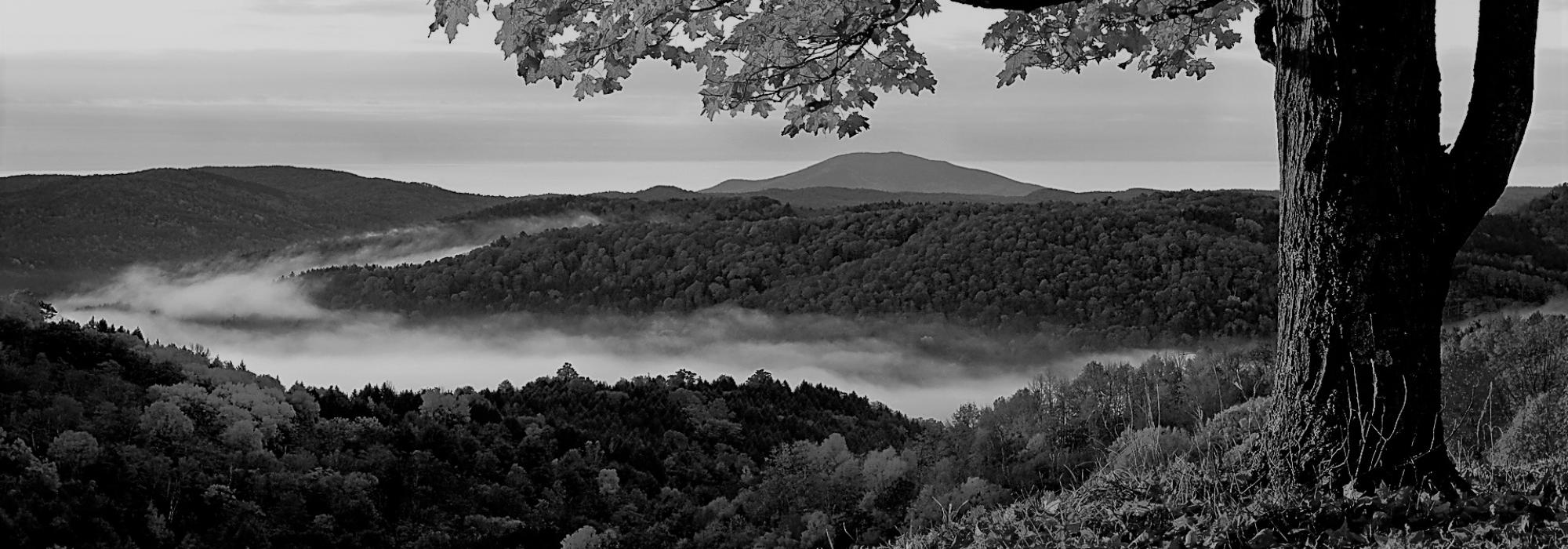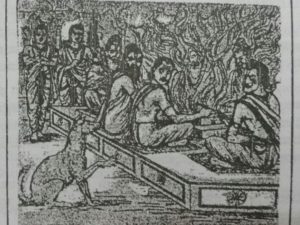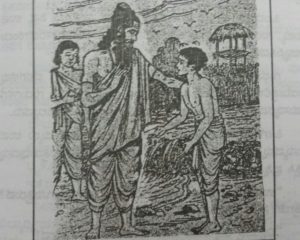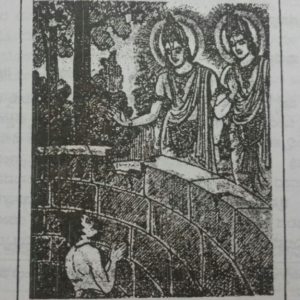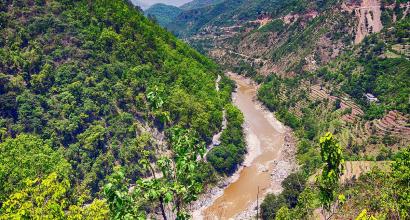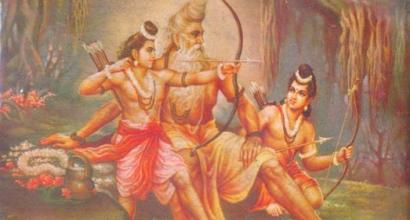The third adhyāya of the Ādi-parva contains the ‘Pauṣya’(upa)parva. The Sūta, Ugraśrava tells the story of Uttaṅka. After completing his studies, Uttaṅka sets out to bring the earrings of King Puṣya’s consort as guru-dakṣiṇa (a token of gratitude to his guru). After acquiring them from the queen, on his way back through a forest, he is harassed by Takṣaka , the king of serpents. Enraged, Uttaṅka goes to King Janamejaya and reminds him that his father died of a snake-bite and instigates the king to perform the sarpa-yāga. This portion of the story is largely in prose. The structure and the style of presentation reminds one of the Brāhmaṇa portion of the Vedas.
The following is the summary of the episode: While Janamejaya, Parikṣit’s son, along with his brothers Śrutasena, Ugrasena and Bhīmasena was performing a dīrgha-satra (an elaborate yāga), a stray puppy appears. Janamejaya’s brothers chase it away. It goes to its mother Saramā and complains. Saramā was a female dog from the heavens. For having harassed her innocent pup, she cursed them that a hitherto unseen fear would get the better of them. Having completed the satra, Janamejaya returns to Hastināpura and appoints the seer Somaśrava as his purohita (royal preceptor). He was born to a female snake. His life’s vow was that he would never refuse the request of a brāhmaṇa. Promising him that he would support him in the observance of his vow, Janamejaya appointed him. Thereafter the king conquered Takṣaśila, the abode of the serpents.
Around this time, a young graduate named Uttaṅka approached his guru Veda and asked what he would like as guru-dakṣiṇa. The guru said that he didn’t want anything. (Perhaps the difficulties that Veda faced with his own guru during his studenthood softened him towards his student, Uttaṅka. There are stories that narrate the ordeals thrust upon Veda and his classmate Upamanyu and Uddālaka-āruṇi by their guru Ayodhadhaumya – see Translators’ Note below for details.) Uttaṅka pestered and finally Veda told him, “Go and ask my wife. Bring her whatever she asks for.” She told him that she wanted the earrings of the queen of King Puṣya. According to her wish, he went to the queen and fetched her earrings. On his way back, when Uttaṅka wanted to wash his hands and feet, he placed the earrings down. Takṣaka , the king of serpents, came in the guise of śramaṇa (ascetic), stole the earrings, and took them away to Nāgaloka (the realm of the serpents). Uttaṅka faced several tribulations before he could win back the earrings for his guru’s wife. Guru Veda and his wife were both pleased that Uttaṅka had brought the dakṣiṇa in the stipulated time. Uttaṅka was naturally annoyed with Takṣaka for all the trouble that he had caused. Therefore he wholeheartedly blessed King Janamejaya, who had conquered Takṣaśila and had arrived at Hastināpura with the word, “O King Supreme! There’s a task that you need to accomplish. You’ve spent your childhood and youth doing everything except this important task.” Upon being questioned about it, Uttaṅka replied, “You have to avenge the torture your father was subject to by Takṣaka . Your father, that noble and innocent soul, was bitten to death by Takṣaka. And Kaśyapa , who was on his way to revive your father from his untimely death was forced to retreat because of Takṣaka . That lowly serpent, filled with arrogance arising out of strength, must be burnt to cinders in the raging fire of the sarpa-yāga, which you must perform. This will avenge the injustice caused to your father and will also gladden my heart, for when I was on my guru’s errand, he put me through a great deal of trouble.” Upon hearing these words, Janamejaya’s fury was kindled.
Translator’s Note:
The third adhyāya of the Ādi-parva narrates a story connected with a contemporary of Janamejaya, Guru Ayodhadhaumya, who had three students - Āruṇi of Pāñcāla, Upamanyu and Veda. Once, the guru asked Āruṇi to repair the broken embankments of a paddy field. Āruṇi, who went to the field, was unable to repair it and laid himself across the embankment, thus checking the water flow. As he did not return for a long time, the guru was worried and went out to the fields looking for Āruṇi. The guru called out for Āruṇi, who immediately got up from his position and came to greet his guru.
Āruṇi told his guru – ‘I was lying down by the fields to check the flow of the water and I got up, came running to you as soon as I heard you call out for me. Command me what I need to do next!’ The Guru Ayodhadhaumya said ‘Hereafter, you will be known as Uddālaka as you built the embankment and now have come breaking it again. As you have followed my command each time, you will attain the best of knowledge’
Upamanyu, who was also a student of Guru Ayodhadhaumya and was asked by his guru to tend the cows. He took care of the cattle during the day and returned home at dusk and prostrated before the guru, waiting for his command. One day, the guru noticed that Upamanyu was growing plump and healthy day by day and asked him how it was possible. Upamanyu said that he was begging for food during the day. The guru said that it was a student’s duty to first offer the procured food to the guru. Upamanyu agreed and brought the food he had got by begging and offered it to his guru. The guru ate the whole portion without leaving anything behind for the student. Upamanyu never questioned his guru and continued his duty of tending the cows and prostrating before the guru in the evening. Guru Ayodhadhaumya, after a few days noticed that Upamanyu was even then as plump and healthy as he formerly was, the guru asked “You offer me all the alms that you procure, but your body has remained as trim as of old. How is it so?” Upamanyu replied – “I offer my gatherings in the first round of alms to you and go for a second round”. Enraged, the guru said “By going begging a second time, you are snatching away another student’s share. It is adharma to do so and you are greedy!” The guru did not tell him how else he was to procure food and the student did not ask him either. Upamanyu knew only to be obedient to his teacher. When he was again found to be plump, after a few days, the guru asked him how it was so and Upamanyu said that he drank the cows’ milk. The guru stopped him from doing so by saying that it was forbidden to drink the milk of the cows that belonged to his āśrama without his permission. After a few days, the guru again noticed that the student was still plump, healthy and was executing his duties as before. When questioned, Upamanyu said that he was feeding on the froth of milk bristling at the mouth of the calves when they had fed their mother’s milk. The guru forbid him from doing so by saying “perhaps, the calves, out of their sympathy for you are letting out much froth from their mouths. You are snatching away some of the share of their food from them. This is not dharma!” As he was forbidden from begging a second time and drinking milk of the cows in any form, Upamanyu took to eating the leaves of the arka plant (crown-flower plant) and turned blind due to the leaf’s injurious quality. Unable to find his way back, he fell into a deep well in the woods. The guru grew anxious as Upamanyu had not returned to the āśrama even after the sun-set. He went with his students to the forest calling out for Upamanyu, only to hear his reply from deep within a well. Upamanyu told him how he ate the arka leaves out of hunger and had thus turned blind. The guru told him to pray to the Aśvinī-devatas to get cured. Upamanyu intensely prayed to them and the Aśvinī-devatas appeared before him. They offered him apūpa (a piece of food), consuming which he would regain his eyes. Upamanyu however refused to eat it without offering it to his teacher. Impressed with the devotion to his guru, they said that when they had offered apūpa to Guru Ayodhadhaumya in the past, he had consumed it without offering it to his own guru and advised Upamanyu to consume it similarly.
However, Upamanyu still refused to follow the example set by his guru and wanted to consume the apūpa only after offering it to him. The Aśvinī-devatas, extremely pleased with his sincerity blessed him by saying – “We are impressed by your devotion. Your guru’s teeth have turned into iron and your teeth are going to turn into gold. You are going to gain divine eye-sight” and vanished. Upamanyu came out of the well and received his guru’s blessings. The guru said “You will be an expert in various fields of knowledge. All the Vedas and dharma-śāstra will always remain etched in your memory”
Veda was the third student of Guru Ayodhadhaumya. The guru once told Veda – “Stay with me for sometime, always serving me. That will bring you great prosperity in life.”Veda agreed and without any complaints put up with every discomfort and hardship in the āśrama. The people of the āśrama, at times, used him in place of oxen to pull the plough and till the land. He withstood thirst, hunger, extreme heat and cold and gladly performed all the work and duties the master imposed on him. The guru was absolutely pleased and with his blessings, Veda became an omniscient. Later, with his guru’s permission, Veda graduated from the gurukula and entered the gṛhasthāśrama. He had three students too and Uttaṅka was one of them.
These difficulties that Veda and his classmates had faced with their own guru during their studenthood had perhaps, softened Veda towards his student, Uttaṅka.
To be continued.
Translated from the Kannada original (ವಚನಭಾರತ). Thanks to Śatāvadhāni Dr. R Ganesh for his astute feedback.

